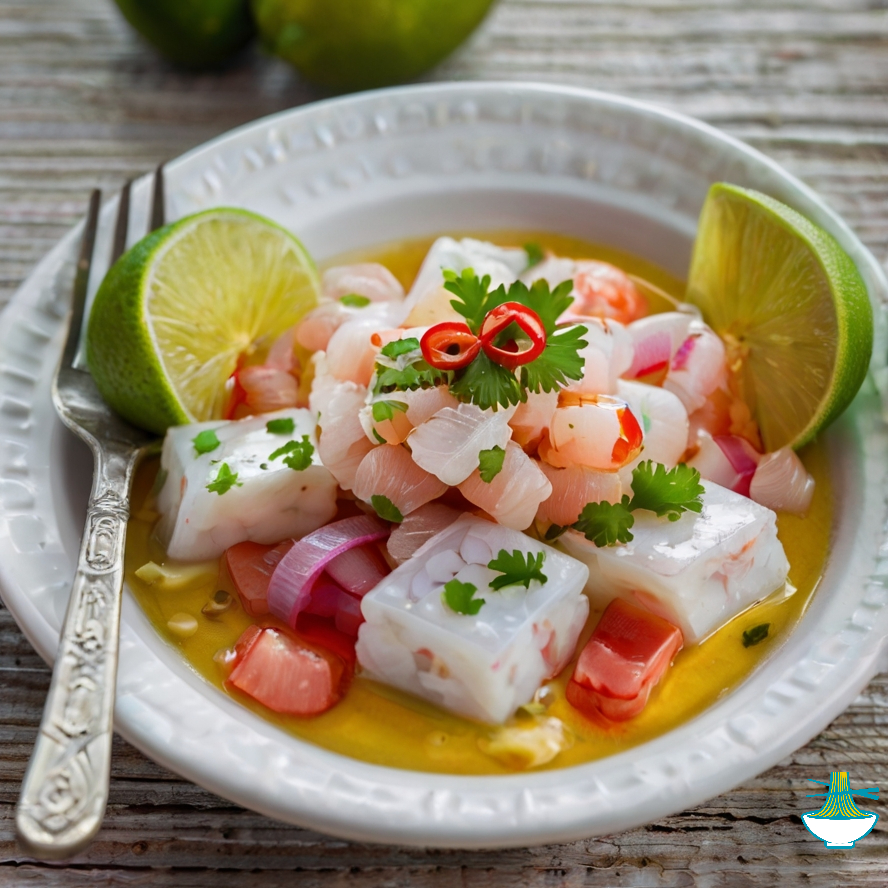Ika Mata known as coconut fish or Raw Fish ,a traditional Polynesian dish,offers a tantalizing blend of fresh flavors and cultural heritage and it easy to cook.
Similar to ceviche, it features raw fish marinated in zesty lime juice and rich coconut cream. This culinary gem reflects the deep connection Polynesian culture has with the bounty of the sea and the lushness of the land. Originating from the Cook Islands and widely enjoyed across the South Pacific, Ika Mata is not just a dish but a celebration of the region's vibrant culinary traditions and natural abundance.
Ingredients:
- 1 lb fresh white fish fillets (such as snapper, mahi-mahi, or tilapia), diced into small cubes
- 3-4 limes, juiced
- 1 cup coconut cream
- 1 small onion, finely diced
- 1 medium tomato, diced
- 1 small cucumber, diced
- 1-2 small chili peppers, finely chopped (optional)
- Salt and pepper to taste
- Fresh cilantro leaves for garnish
Method:
1. In a non-metallic bowl, place the diced fish and pour the lime juice over it. Make sure the fish is completely covered in the lime juice. Let it marinate in the refrigerator for about 30 minutes to 1 hour, or until the fish turns opaque and "cooks" in the lime juice (this process is called "denaturing").
2. Once the fish is "cooked" in the lime juice, drain any excess liquid.
3. Add the coconut cream to the fish and gently mix until well combined.
4. Add the diced onion, tomato, cucumber, and chili peppers (if using) to the fish mixture. Season with salt and pepper to taste. Mix gently to combine all the ingredients.
5. Cover the bowl and refrigerate for at least 1 hour to allow the flavors to meld together.
6. Before serving, give the Ika Mata a final stir. Taste and adjust seasoning if necessary.
7. Serve chilled, garnished with fresh cilantro leaves.
Enjoy your delicious Polynesian Ika Mata!
Nutrition Value:
1. Fresh White Fish Fillets:
- Calories: Approximately 160 calories per 4-ounce serving
- Protein: Rich source, providing about 20-25 grams per serving
- Fat: Low in fat, typically less than 5 grams per serving
- Sodium: Varies, but generally low in sodium
- Cholesterol: Varies, but generally low in cholesterol
- Vitamins & Minerals: Excellent source of B vitamins (especially B12), selenium, and phosphorus. Also contains potassium, magnesium, and some vitamin D.
- Nutritional Benefit: High-quality protein source, rich in essential nutrients, supports muscle growth and repair, and contributes to overall health.
2. Limes (Juiced):
- Calories: Approximately 8 calories per lime
- Carbohydrates: Provides about 2-3 grams of carbohydrates per lime
- Vitamin C: Excellent source, providing over 20% of the daily recommended intake per lime
- Nutritional Benefit: Rich in vitamin C, which supports immune function, collagen synthesis, and iron absorption. Also adds flavor and acidity to the dish.
3. Coconut Cream:
- Calories: Approximately 330 calories per cup
- Carbohydrates: Provides around 7 grams of carbohydrates per serving
- Fat: High in fat, primarily saturated fat, providing around 33 grams per serving
- Sodium: Varies, but can be moderate to low in sodium
- Cholesterol: May contain trace amounts of cholesterol
- Vitamins & Minerals: Contains some vitamins and minerals, including iron, manganese, copper, and selenium.
- Nutritional Benefit: Adds richness and creaminess to the dish, but should be consumed in moderation due to its high saturated fat content.
4. Onion:
- Calories: Approximately 40 calories per small onion
- Carbohydrates: Provides around 10 grams of carbohydrates per onion
- Fiber: Good source, offering around 2-3 grams of fiber per onion
- Vitamin C: Contains some vitamin C
- Nutritional Benefit: Low in calories and a good source of fiber and flavor. Onions also contain antioxidants and compounds that may have health benefits, such as quercetin.
5. Tomato:
- Calories: Approximately 20 calories per medium tomato
- Carbohydrates: Provides around 4-5 grams of carbohydrates per tomato
- Vitamin C: Good source, offering over 20% of the daily recommended intake per tomato
- Vitamin A: Contains some vitamin A in the form of beta-carotene
- Nutritional Benefit: Low in calories and rich in vitamins and antioxidants, including lycopene, which may have protective effects against certain diseases.
6. Cucumber:
- Calories: Approximately 15 calories per small cucumber
- Carbohydrates: Provides around 3-4 grams of carbohydrates per cucumber
- Fiber: Contains some fiber, offering around 1 gram per cucumber
- Vitamin K: Good source, providing over 10% of the daily recommended intake per cucumber
- Nutritional Benefit: Low in calories and refreshing, cucumbers are hydrating and rich in vitamins and minerals, including vitamin K and potassium.
7. Chili Peppers (Optional):
- Calories: Varies depending on the type and amount used
- Carbohydrates: Varies, but generally low in carbohydrates
- Vitamin C: Contains vitamin C, with spicier varieties typically providing more
- Capsaicin: Active compound responsible for the heat, may have various health benefits, including pain relief and metabolism boosting effects.
- Nutritional Benefit: Adds heat and flavor to the dish, and may provide health benefits due to the presence of capsaicin.
8. Salt and Pepper:
- Salt: Should be used sparingly to control sodium intake
- Pepper: Adds flavor without adding calories or significant nutrients
9. Fresh Cilantro Leaves:
- Calories: Negligible
- Nutritional Benefit: Contains small amounts of vitamins and minerals, including vitamin K and antioxidants. Adds freshness and flavor to the dish.
Overall, this dish provides a balance of protein, healthy fats, vitamins, and minerals, making it a nutritious and flavorful option. Adjustments can be made to accommodate dietary preferences and nutritional needs.


Comments